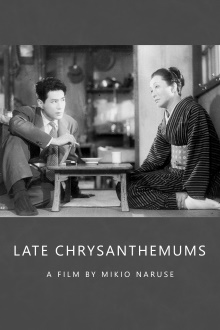Mikio Naruse is a contemporary of Ozu and indeed you can recognize many of the same actors and actresses the more famous director uses in this film. Yet while this is visually very similar to Ozu’s work and it is also a drama about ordinary people in what was then modern Japan, the tone of the film could not be more different. Unlike Ozu’s films which are always pleasant no matter the ignoble motives of some characters, Late Chrysanthemums does not shy away from confronting head-on the ugliness of people and the decrepit conditions under which they sometimes live. This film perhaps lacks the finely-tuned sense of drama of Ozu’s masterpieces but it feels to me like a more realistic portrayal of ordinary life in that era.
A group of four former geisha make lives for themselves in post-war Tokyo. The most well-off is Okin who never married and saved enough of her money to be a successful moneylender and investor. She lends money to the other three who grouse about her always chasing them for repayment. Only of the four has married and runs a restaurant with her husband, though the film has little to say about her. The other two, Tamae and Tomi, live together and are widows each with an adult child of their own. Tamae suffers from migraines which makes it difficult for her to work while Tomi frequently gambles away her money. Both of their children are leaving for partners that their mothers don’t quite approve of, which causes them some distress. Meanwhile an old patron of Okin shows up. He was once so obsessed with her that he tried to kill her so that they would die together. Okin cares for him not at all though the others seem to be impressed by how much he loved her and sacrificed for her. She does pine for another former customer who is particularly handsome but has since married and no longer visits her.
Ozu’s films are rightfully hailed as masterpieces of world cinema but it always bothered me how they always present a sort of idealized vision of Japanese society. While the characters in them obviously have problems in their lives, the films always uphold impeccable propriety. The characters are invariably affable, interact pleasantly with one another and their homes, even for those who aren’t rich, are always neat and well-ordered. That’s why watching this contemporaneous work is such an eye-opener and palate cleanser. Here Tamae and Tomi’s house is appropriately messy and run-down in line with their personal troubles. Manners and the fact that they owe money to her force the other characters to behave appropriately to Okin yet here they subtly weaponize the courtesies to insult her. Behind her back, they don’t hold back at all. One even all but runs her out of the house by splashing water in her wake. In one scene, Okin at first welcomes a guest but then increasingly gets annoyed as the drunken guest overstays his welcome. Tomi’s modern daughter, knowing of her gambling habits, refuses to give her any money and doesn’t hesitate to tell her off even as she grumbles about unfilial children. It’s so great to see how Japanese people in that era are just people like anywhere else.
I was also surprised that the director refrains from making traditional value judgments, given that this is after all a film from the 1950s. Tamae and Tomi are miserable about their children leaving them but continue to affirm that their children mean everything to them. Okin disdains having a husband or children, reasoning that they will all eventually leave anyway. She comforts herself by being independent and having money. She seems to work well enough with a man who serves as her real estate agent and investment partner and lives comfortably with a deaf-and-dumb girl who works as works as her household servant. Another film from that era might have chosen to give her a bad ending, to show that her pursuit of money leads only to misery. Instead however the film ensures that her wariness of men is justified and that any lingering sense of romanticism that she has is ruthlessly smothered. To be fair, it’s not that she is necessarily happier than any of the others but it does show that her chosen lifestyle at least isn’t any less valid or something to be ashamed of. I do believe that this makes for an early example of strong female representation in film and affirms a very practical way of life that seems rather rare to me.
This is the first film we’ve watched by Naruse and as I’ve learned that the director is known for such female protagonists, I am surely interested in seeing more of his work. On the other hand, his work is also known to be pessimistic and it’s likely that his female characters are forced into such non-traditional roles due to the extreme poverty and economic distress of post-war Japan, so it’s probably not wise to interpret his views as being progressive in the modern sense. Still I think it will be fascinating to see more of this side of Japan and the fact that it is superficially so similar to Ozu’s own work makes it even more appealing.
